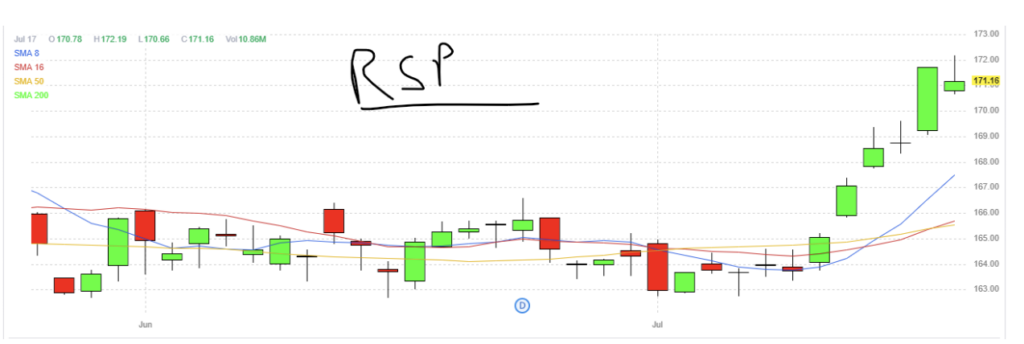Let’s assume the Fed does cut rates in September, much to the chagrin of Republicans, investors are now looking for stocks that have room for appreciation. Since most of the rally of 2024 has been due to the Mag-7 (Meta, Apple, Amazon, Microsoft, Nvidia, and Tesla), institutions are now looking to other sectors and stocks that have lower valuations and that have the potential to gain more on a percentage basis once the rate cut takes effect.
In other words, the Mag-7 and its cash reserves could withstand higher interest rates, while many small-caps, relying on borrowing funds for future investments, had to buckle down this past year.
So, if interest rates come down, the small caps can start borrowing again and potentially appreciating. From an investment perspective, it may be easier for an investor to see returns from a small-cap company than a behemoth like Microsoft rise another 10% in the second half of the year.
That’s why you’ve seen the Russell 2000 (IWM) wake up from its slumber. The small-cap index took off last week. The IWM ETF rose as much as 11% in 5 trading days!

Then you had the Equal Weight S&P 500 Index (RSP) follow suit as the bullishness of the year finally broadened out to other stocks.

The index climbed as much as 5% in 5 trading days.
Even Gold (GLD) broke free from its range and ran higher.

What other sectors will benefit from reduced rates from the Fed? In short, Financials.
Banks and other financial institutions can benefit when the Federal Reserve cuts interest rates for several reasons:
- Increased Borrowing and Lending Activity
Lower interest rates generally make borrowing cheaper for consumers and businesses. This can lead to:
- Higher Loan Demand: More people and businesses take out loans for mortgages, car purchases, business expansion, etc.
- Increased Lending Volume: Banks can issue more loans, boosting their interest income despite lower rates.
- Improved Credit Conditions
Lower interest rates can improve the overall credit environment:
- Lower Default Rates: Borrowers are more likely to repay loans when interest rates are lower, reducing the risk of defaults.
- Stronger Balance Sheets: Financial institutions might see an improvement in the quality of their loan portfolios, leading to healthier balance sheets.
As a result, the Financials ETF, XLK, has been taking off since July with the anticipation of a September rate cut.

I had the opportunity to trade XLF in front of a live group of investors earlier this week and we were able to clear a 10% return on risk in just over an hour!
If you want to see the technique we used and how you can make trades just like it, I recommend coming to our Millionaires Trader Clube event this October. You can find out more by going here.
Have a good weekend everyone! Oh, and make sure you get your MTC ticket, because I’m told the hotel is booking fast!


